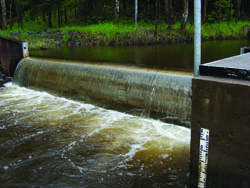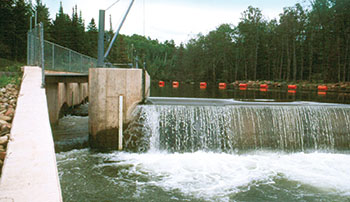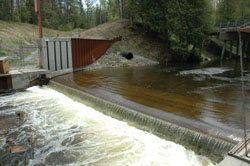Sea Lamprey Barriers
Limiting sea lamprey access to spawning habitat
Barriers to sea lamprey migration are physical structures placed in tributaries that block access of adult sea lampreys to spawning habitat.
The network of sea lamprey barriers consists of purpose-built barriers as well as numerous dams constructed for other purposes that also serve to block upstream migration of adult sea lampreys. The location and design of purpose-built barriers are determined by a team of experts and are generally designed to block adults while allowing jumping fish to pass safely. The commission partners with the U.S. Army Corps of Engineers to design and construct physical structures for sea lamprey control.

While purpose-built barriers are inspected on a regular basis and repaired or replaced when necessary to ensure they continue to block adult sea lampreys, many dams constructed for other purposes are being removed to improve fish passage or have been permitted to deteriorate, threatening their ability to block migrating adults. The current network of barriers prevents adults from accessing thousands of miles of habitat, thereby reducing sea lamprey production and saving millions of treatment dollars, but dam removal and deterioration pose an ongoing threat to effective sea lamprey control.

Prior to the discovery of the lampricide TFM in the late 1950s, sea lamprey control relied exclusively on crude mechanical and electrical barriers to prevent adult sea lampreys from accessing spawning habitats. These barriers were unreliable, expensive to operate, and dangerous to humans and wildlife; they were eventually phased out in favor of lampricides. In the 1970s, the commission re-evaluated the importance of barriers and concluded that properly constructed barriers could block adults and minimize the need for lampricide treatments. The commission has built approximately 50 barriers since, all serving to limit adult access to spawning habitat, the extent of infestation, and the need for lampricide treatment. Roughly 20 more dams that were constructed for other purposes have been modified to block adult migrations. Currently, the focus of the barrier program is on maintenance of existing barriers and the construction of new barriers with built-in traps designed to capture adults.
Sea lamprey barrier designs
Most purpose-built sea lamprey barriers use a "low-head" crest design. Because adult sea lampreys cannot jump very high, the creation of a two to four foot vertical drop is sufficient to stop adults from migrating upstream. A horizontal lip along the crest of the barrier keeps adults from using their suction-cup mouth to climb over it. Traps are typically installed during new barrier construction to remove adults before they have a chance to spawn and enable assessment of their populations. Inclusion of a jumping pool downstream of the barrier allows most jumping fish to pass easily. To pass non-jumping fish, some barriers have a "trap-and-sort" fishway where sea lampreys are trapped, sorted, and removed while desirable fish are moved upstream.

Many dams built for other purposes also block adult sea lampreys; such structures are numerous around the Great Lakes and are of great importance to sea lamprey control. Maintaining the integrity of these barriers is critical because many of them are old and in poor condition such that their ability to block adults will be compromised in the near future. Additionally, many of these barriers are located on large tributaries with huge sea lamprey production potential, making it all the more critical to maintain their integrity.
Dam removal considerations

Dam removal in the Great Lakes basin can have tremendous overall benefits to a tributary system. At the same time, however, there are significant drawbacks to consider. Although dam removal will increase habitat connectivity and often aids in the rehabilitation of an ecosystem, it also allows for the spread of invasive species into new ecosystems. Balancing the use of sea lamprey barriers with dam removal is a growing issue that will need to be managed to ensure the viability of sea lamprey control and to protect the Great Lakes fishery.

